Independent Living and Assistive Technology: A Comprehensive Report
VerifiedAdded on 2020/07/22
|12
|3960
|408
Report
AI Summary
This report analyzes the role of technology in supporting independent living, focusing on a case study of a 42-year-old woman named Sally diagnosed with multiple sclerosis. It examines various assistive technologies like Pocket Coach, spinner knobs, special keyboards, and sensory products that can help individuals with disabilities perform daily activities. The report discusses the barriers to using these technologies, including budget constraints, technology resistance, and ethical issues, while also highlighting the benefits, such as promoting health and safety, and increasing the quality of care. Furthermore, it delves into health and safety considerations, ethical aspects, and the impact of emerging technological developments on health and social care services. The report also identifies the specific needs of another individual, Maggie, and recommends appropriate assistive devices to support her independent living, evaluating the overall usefulness of technology for users in health and social care settings. The report emphasizes the importance of training and ethical considerations in implementing these technologies to improve the quality of life for individuals with disabilities.
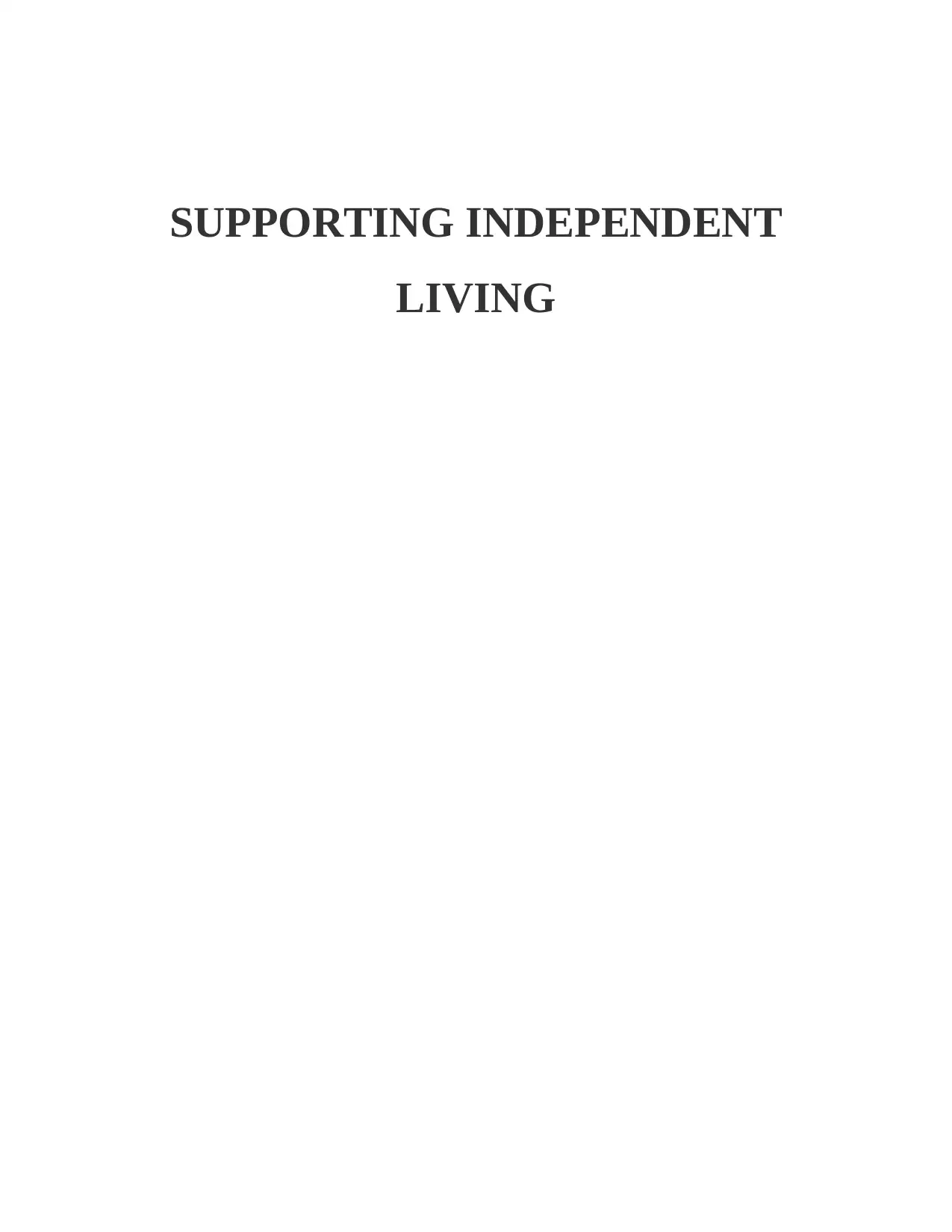
SUPPORTING INDEPENDENT
LIVING
LIVING
Paraphrase This Document
Need a fresh take? Get an instant paraphrase of this document with our AI Paraphraser
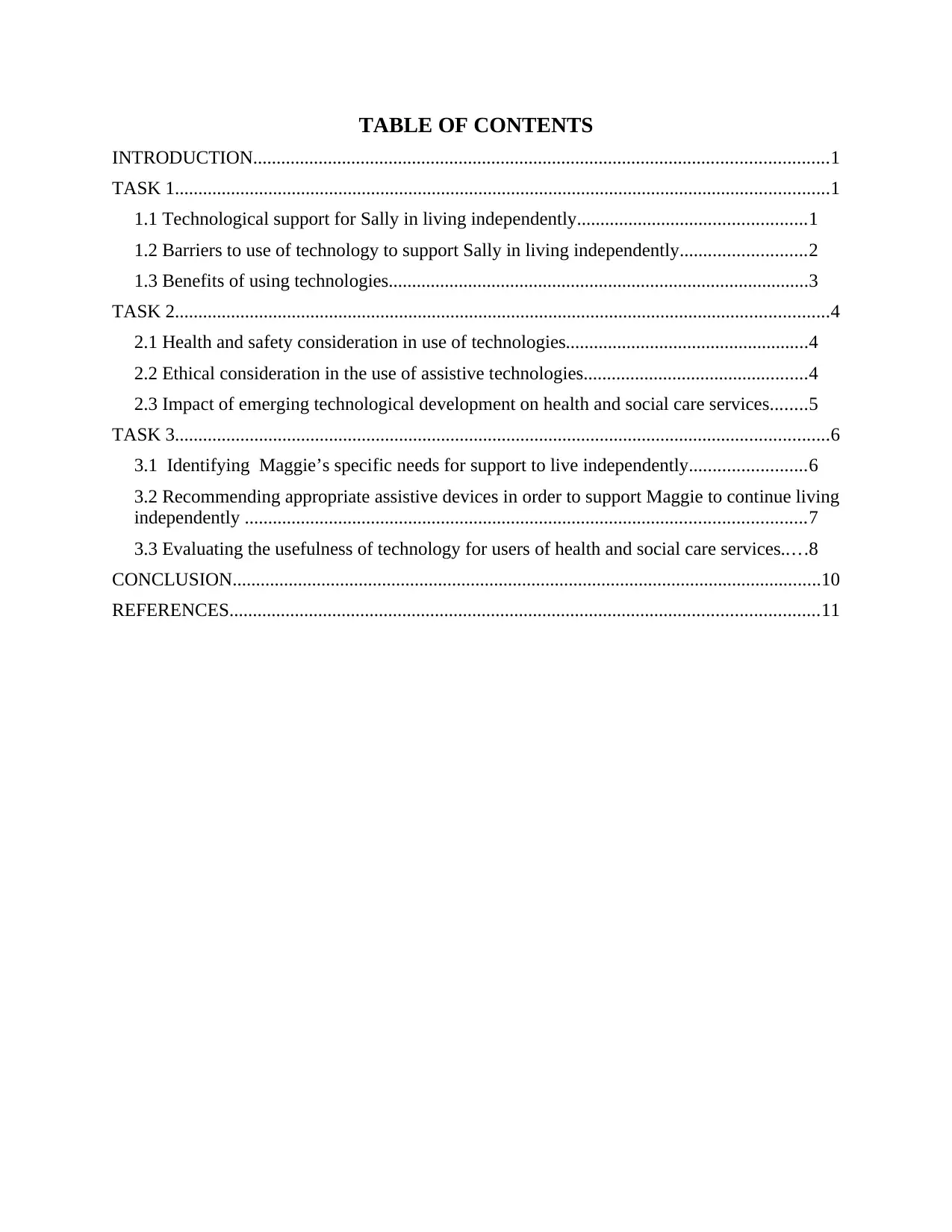
TABLE OF CONTENTS
INTRODUCTION...........................................................................................................................1
TASK 1............................................................................................................................................1
1.1 Technological support for Sally in living independently.................................................1
1.2 Barriers to use of technology to support Sally in living independently...........................2
1.3 Benefits of using technologies..........................................................................................3
TASK 2............................................................................................................................................4
2.1 Health and safety consideration in use of technologies....................................................4
2.2 Ethical consideration in the use of assistive technologies................................................4
2.3 Impact of emerging technological development on health and social care services........5
TASK 3............................................................................................................................................6
3.1 Identifying Maggie’s specific needs for support to live independently.........................6
3.2 Recommending appropriate assistive devices in order to support Maggie to continue living
independently ........................................................................................................................7
3.3 Evaluating the usefulness of technology for users of health and social care services.....8
CONCLUSION..............................................................................................................................10
REFERENCES..............................................................................................................................11
INTRODUCTION...........................................................................................................................1
TASK 1............................................................................................................................................1
1.1 Technological support for Sally in living independently.................................................1
1.2 Barriers to use of technology to support Sally in living independently...........................2
1.3 Benefits of using technologies..........................................................................................3
TASK 2............................................................................................................................................4
2.1 Health and safety consideration in use of technologies....................................................4
2.2 Ethical consideration in the use of assistive technologies................................................4
2.3 Impact of emerging technological development on health and social care services........5
TASK 3............................................................................................................................................6
3.1 Identifying Maggie’s specific needs for support to live independently.........................6
3.2 Recommending appropriate assistive devices in order to support Maggie to continue living
independently ........................................................................................................................7
3.3 Evaluating the usefulness of technology for users of health and social care services.....8
CONCLUSION..............................................................................................................................10
REFERENCES..............................................................................................................................11
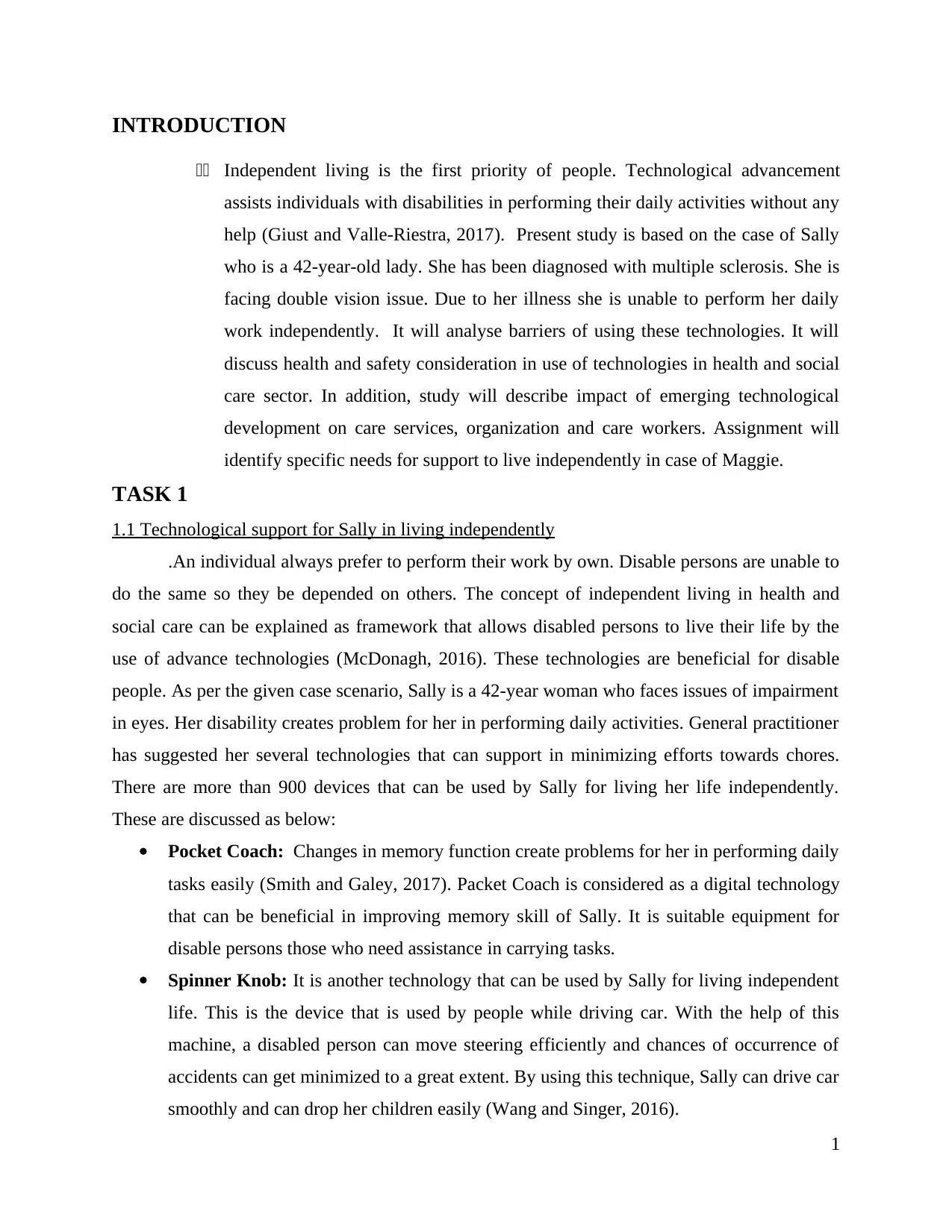
INTRODUCTION
11 Independent living is the first priority of people. Technological advancement
assists individuals with disabilities in performing their daily activities without any
help (Giust and Valle-Riestra, 2017). Present study is based on the case of Sally
who is a 42-year-old lady. She has been diagnosed with multiple sclerosis. She is
facing double vision issue. Due to her illness she is unable to perform her daily
work independently. It will analyse barriers of using these technologies. It will
discuss health and safety consideration in use of technologies in health and social
care sector. In addition, study will describe impact of emerging technological
development on care services, organization and care workers. Assignment will
identify specific needs for support to live independently in case of Maggie.
TASK 1
1.1 Technological support for Sally in living independently
.An individual always prefer to perform their work by own. Disable persons are unable to
do the same so they be depended on others. The concept of independent living in health and
social care can be explained as framework that allows disabled persons to live their life by the
use of advance technologies (McDonagh, 2016). These technologies are beneficial for disable
people. As per the given case scenario, Sally is a 42-year woman who faces issues of impairment
in eyes. Her disability creates problem for her in performing daily activities. General practitioner
has suggested her several technologies that can support in minimizing efforts towards chores.
There are more than 900 devices that can be used by Sally for living her life independently.
These are discussed as below:
Pocket Coach: Changes in memory function create problems for her in performing daily
tasks easily (Smith and Galey, 2017). Packet Coach is considered as a digital technology
that can be beneficial in improving memory skill of Sally. It is suitable equipment for
disable persons those who need assistance in carrying tasks.
Spinner Knob: It is another technology that can be used by Sally for living independent
life. This is the device that is used by people while driving car. With the help of this
machine, a disabled person can move steering efficiently and chances of occurrence of
accidents can get minimized to a great extent. By using this technique, Sally can drive car
smoothly and can drop her children easily (Wang and Singer, 2016).
1
11 Independent living is the first priority of people. Technological advancement
assists individuals with disabilities in performing their daily activities without any
help (Giust and Valle-Riestra, 2017). Present study is based on the case of Sally
who is a 42-year-old lady. She has been diagnosed with multiple sclerosis. She is
facing double vision issue. Due to her illness she is unable to perform her daily
work independently. It will analyse barriers of using these technologies. It will
discuss health and safety consideration in use of technologies in health and social
care sector. In addition, study will describe impact of emerging technological
development on care services, organization and care workers. Assignment will
identify specific needs for support to live independently in case of Maggie.
TASK 1
1.1 Technological support for Sally in living independently
.An individual always prefer to perform their work by own. Disable persons are unable to
do the same so they be depended on others. The concept of independent living in health and
social care can be explained as framework that allows disabled persons to live their life by the
use of advance technologies (McDonagh, 2016). These technologies are beneficial for disable
people. As per the given case scenario, Sally is a 42-year woman who faces issues of impairment
in eyes. Her disability creates problem for her in performing daily activities. General practitioner
has suggested her several technologies that can support in minimizing efforts towards chores.
There are more than 900 devices that can be used by Sally for living her life independently.
These are discussed as below:
Pocket Coach: Changes in memory function create problems for her in performing daily
tasks easily (Smith and Galey, 2017). Packet Coach is considered as a digital technology
that can be beneficial in improving memory skill of Sally. It is suitable equipment for
disable persons those who need assistance in carrying tasks.
Spinner Knob: It is another technology that can be used by Sally for living independent
life. This is the device that is used by people while driving car. With the help of this
machine, a disabled person can move steering efficiently and chances of occurrence of
accidents can get minimized to a great extent. By using this technique, Sally can drive car
smoothly and can drop her children easily (Wang and Singer, 2016).
1
⊘ This is a preview!⊘
Do you want full access?
Subscribe today to unlock all pages.

Trusted by 1+ million students worldwide
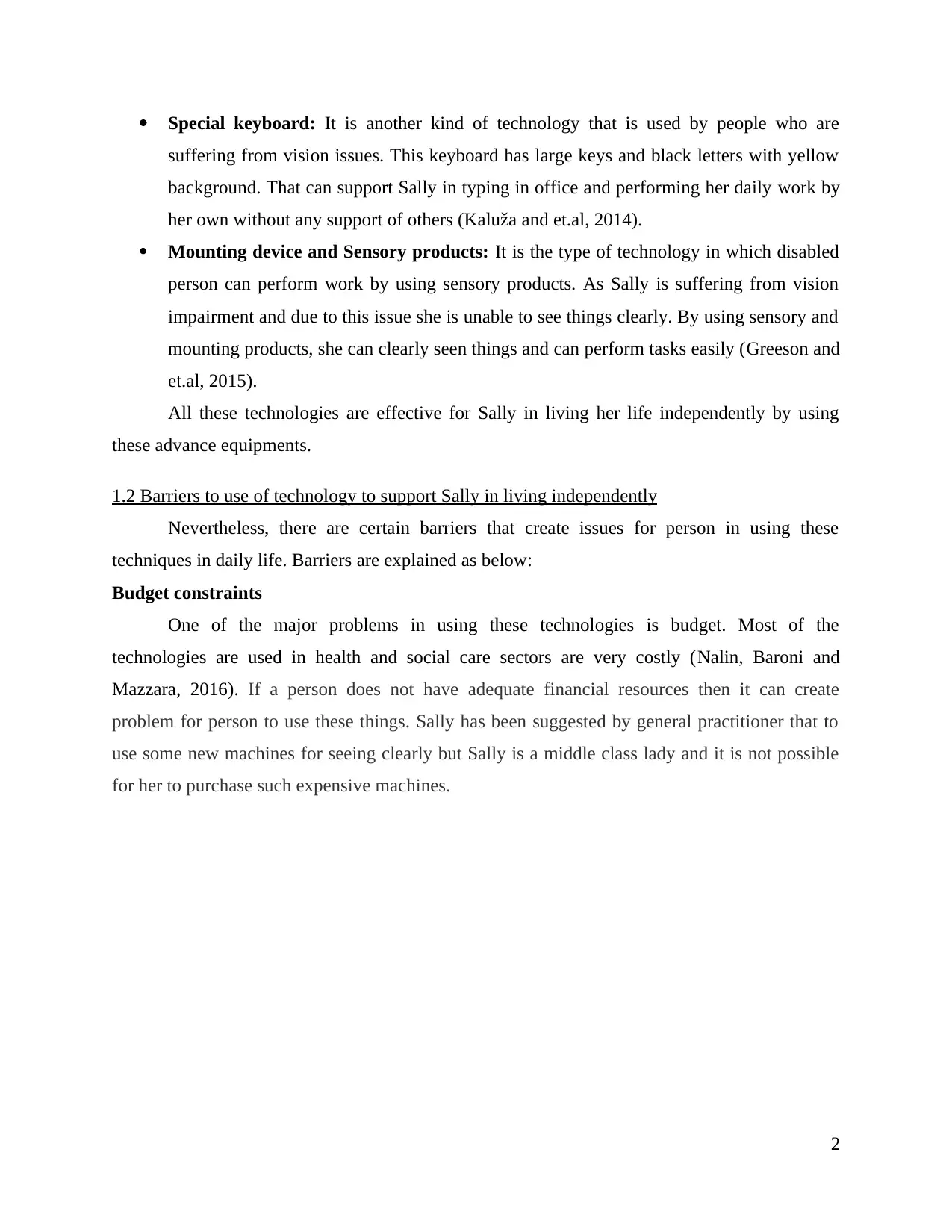
Special keyboard: It is another kind of technology that is used by people who are
suffering from vision issues. This keyboard has large keys and black letters with yellow
background. That can support Sally in typing in office and performing her daily work by
her own without any support of others (Kaluža and et.al, 2014).
Mounting device and Sensory products: It is the type of technology in which disabled
person can perform work by using sensory products. As Sally is suffering from vision
impairment and due to this issue she is unable to see things clearly. By using sensory and
mounting products, she can clearly seen things and can perform tasks easily (Greeson and
et.al, 2015).
All these technologies are effective for Sally in living her life independently by using
these advance equipments.
1.2 Barriers to use of technology to support Sally in living independently
Nevertheless, there are certain barriers that create issues for person in using these
techniques in daily life. Barriers are explained as below:
Budget constraints
One of the major problems in using these technologies is budget. Most of the
technologies are used in health and social care sectors are very costly (Nalin, Baroni and
Mazzara, 2016). If a person does not have adequate financial resources then it can create
problem for person to use these things. Sally has been suggested by general practitioner that to
use some new machines for seeing clearly but Sally is a middle class lady and it is not possible
for her to purchase such expensive machines.
2
suffering from vision issues. This keyboard has large keys and black letters with yellow
background. That can support Sally in typing in office and performing her daily work by
her own without any support of others (Kaluža and et.al, 2014).
Mounting device and Sensory products: It is the type of technology in which disabled
person can perform work by using sensory products. As Sally is suffering from vision
impairment and due to this issue she is unable to see things clearly. By using sensory and
mounting products, she can clearly seen things and can perform tasks easily (Greeson and
et.al, 2015).
All these technologies are effective for Sally in living her life independently by using
these advance equipments.
1.2 Barriers to use of technology to support Sally in living independently
Nevertheless, there are certain barriers that create issues for person in using these
techniques in daily life. Barriers are explained as below:
Budget constraints
One of the major problems in using these technologies is budget. Most of the
technologies are used in health and social care sectors are very costly (Nalin, Baroni and
Mazzara, 2016). If a person does not have adequate financial resources then it can create
problem for person to use these things. Sally has been suggested by general practitioner that to
use some new machines for seeing clearly but Sally is a middle class lady and it is not possible
for her to purchase such expensive machines.
2
Paraphrase This Document
Need a fresh take? Get an instant paraphrase of this document with our AI Paraphraser
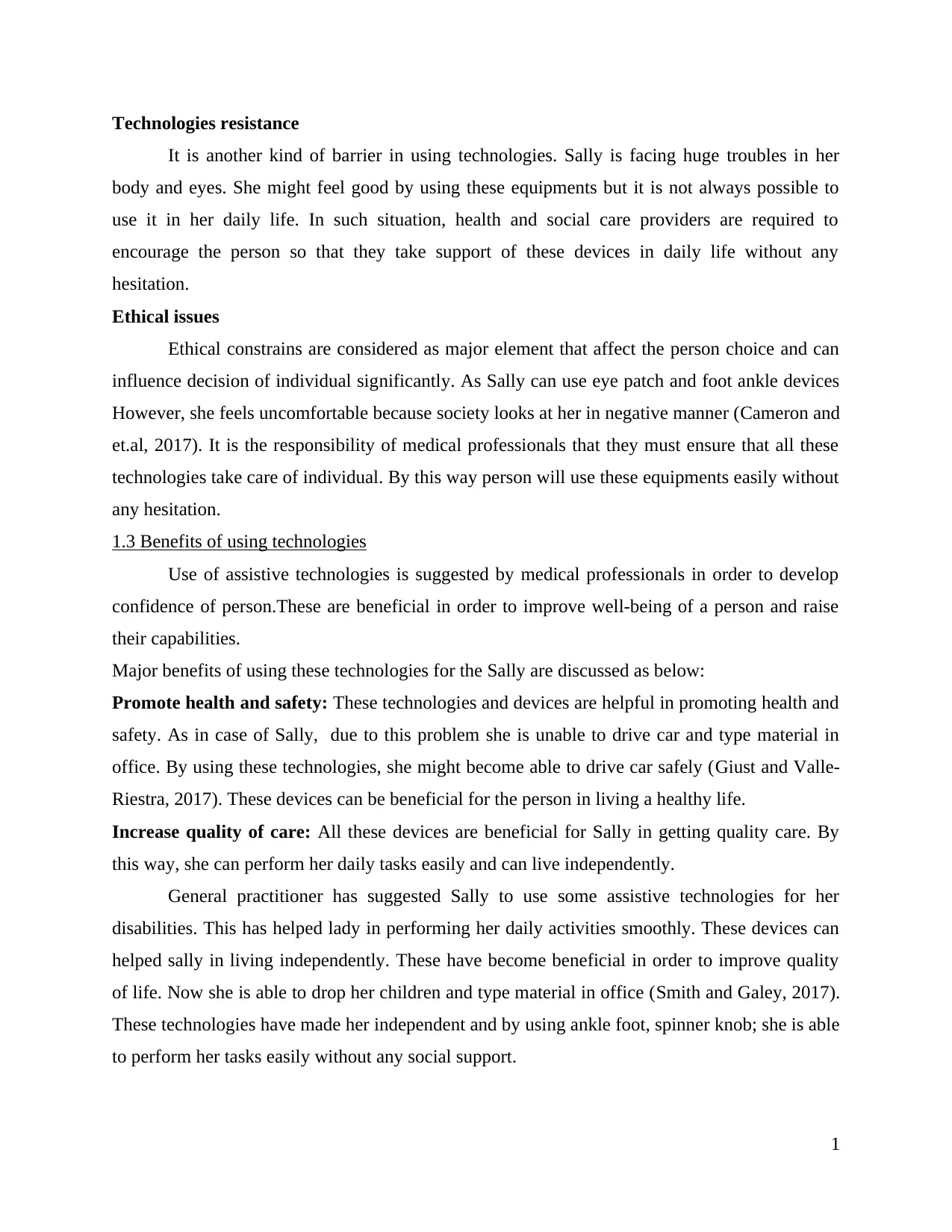
Technologies resistance
It is another kind of barrier in using technologies. Sally is facing huge troubles in her
body and eyes. She might feel good by using these equipments but it is not always possible to
use it in her daily life. In such situation, health and social care providers are required to
encourage the person so that they take support of these devices in daily life without any
hesitation.
Ethical issues
Ethical constrains are considered as major element that affect the person choice and can
influence decision of individual significantly. As Sally can use eye patch and foot ankle devices
However, she feels uncomfortable because society looks at her in negative manner (Cameron and
et.al, 2017). It is the responsibility of medical professionals that they must ensure that all these
technologies take care of individual. By this way person will use these equipments easily without
any hesitation.
1.3 Benefits of using technologies
Use of assistive technologies is suggested by medical professionals in order to develop
confidence of person.These are beneficial in order to improve well-being of a person and raise
their capabilities.
Major benefits of using these technologies for the Sally are discussed as below:
Promote health and safety: These technologies and devices are helpful in promoting health and
safety. As in case of Sally, due to this problem she is unable to drive car and type material in
office. By using these technologies, she might become able to drive car safely (Giust and Valle-
Riestra, 2017). These devices can be beneficial for the person in living a healthy life.
Increase quality of care: All these devices are beneficial for Sally in getting quality care. By
this way, she can perform her daily tasks easily and can live independently.
General practitioner has suggested Sally to use some assistive technologies for her
disabilities. This has helped lady in performing her daily activities smoothly. These devices can
helped sally in living independently. These have become beneficial in order to improve quality
of life. Now she is able to drop her children and type material in office (Smith and Galey, 2017).
These technologies have made her independent and by using ankle foot, spinner knob; she is able
to perform her tasks easily without any social support.
1
It is another kind of barrier in using technologies. Sally is facing huge troubles in her
body and eyes. She might feel good by using these equipments but it is not always possible to
use it in her daily life. In such situation, health and social care providers are required to
encourage the person so that they take support of these devices in daily life without any
hesitation.
Ethical issues
Ethical constrains are considered as major element that affect the person choice and can
influence decision of individual significantly. As Sally can use eye patch and foot ankle devices
However, she feels uncomfortable because society looks at her in negative manner (Cameron and
et.al, 2017). It is the responsibility of medical professionals that they must ensure that all these
technologies take care of individual. By this way person will use these equipments easily without
any hesitation.
1.3 Benefits of using technologies
Use of assistive technologies is suggested by medical professionals in order to develop
confidence of person.These are beneficial in order to improve well-being of a person and raise
their capabilities.
Major benefits of using these technologies for the Sally are discussed as below:
Promote health and safety: These technologies and devices are helpful in promoting health and
safety. As in case of Sally, due to this problem she is unable to drive car and type material in
office. By using these technologies, she might become able to drive car safely (Giust and Valle-
Riestra, 2017). These devices can be beneficial for the person in living a healthy life.
Increase quality of care: All these devices are beneficial for Sally in getting quality care. By
this way, she can perform her daily tasks easily and can live independently.
General practitioner has suggested Sally to use some assistive technologies for her
disabilities. This has helped lady in performing her daily activities smoothly. These devices can
helped sally in living independently. These have become beneficial in order to improve quality
of life. Now she is able to drop her children and type material in office (Smith and Galey, 2017).
These technologies have made her independent and by using ankle foot, spinner knob; she is able
to perform her tasks easily without any social support.
1
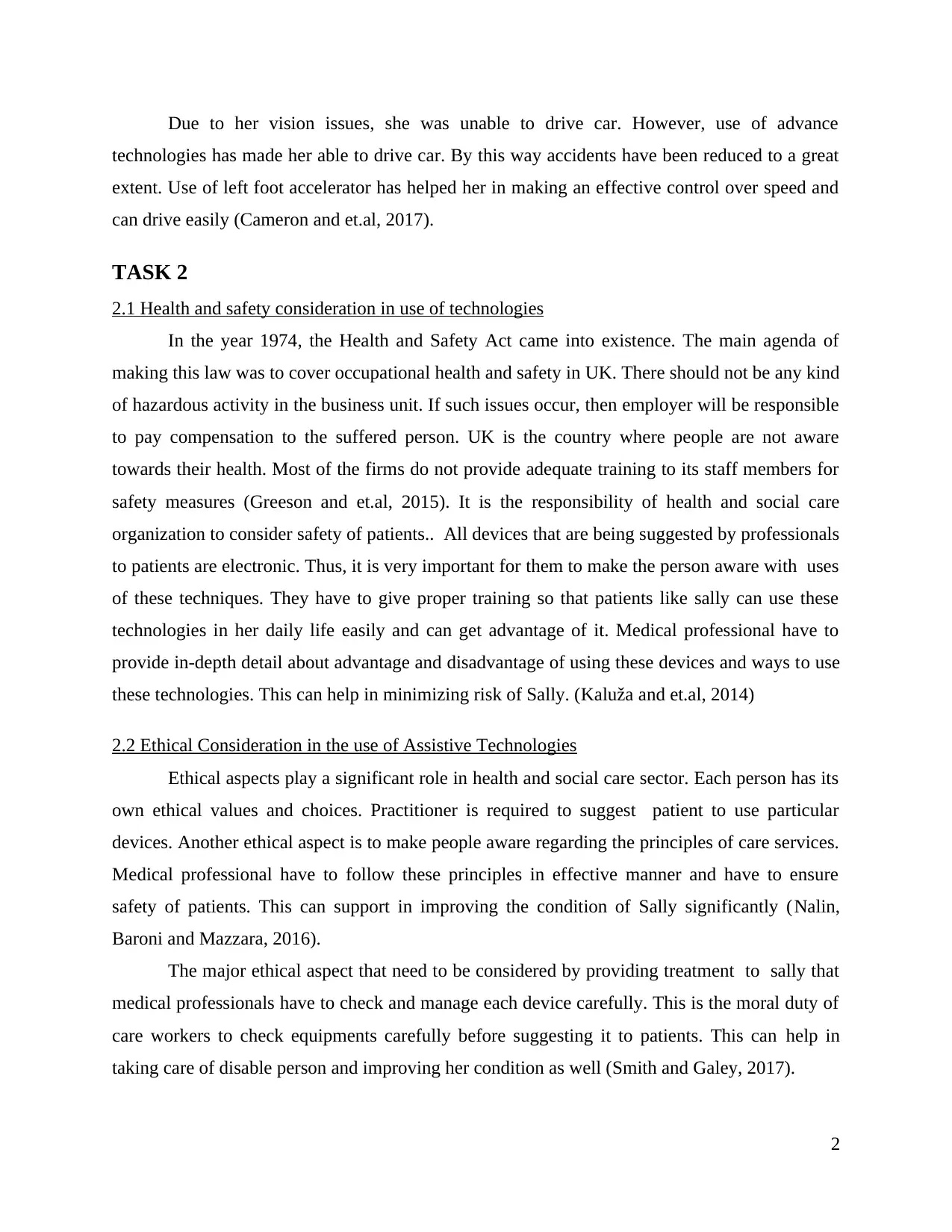
Due to her vision issues, she was unable to drive car. However, use of advance
technologies has made her able to drive car. By this way accidents have been reduced to a great
extent. Use of left foot accelerator has helped her in making an effective control over speed and
can drive easily (Cameron and et.al, 2017).
TASK 2
2.1 Health and safety consideration in use of technologies
In the year 1974, the Health and Safety Act came into existence. The main agenda of
making this law was to cover occupational health and safety in UK. There should not be any kind
of hazardous activity in the business unit. If such issues occur, then employer will be responsible
to pay compensation to the suffered person. UK is the country where people are not aware
towards their health. Most of the firms do not provide adequate training to its staff members for
safety measures (Greeson and et.al, 2015). It is the responsibility of health and social care
organization to consider safety of patients.. All devices that are being suggested by professionals
to patients are electronic. Thus, it is very important for them to make the person aware with uses
of these techniques. They have to give proper training so that patients like sally can use these
technologies in her daily life easily and can get advantage of it. Medical professional have to
provide in-depth detail about advantage and disadvantage of using these devices and ways to use
these technologies. This can help in minimizing risk of Sally. (Kaluža and et.al, 2014)
2.2 Ethical Consideration in the use of Assistive Technologies
Ethical aspects play a significant role in health and social care sector. Each person has its
own ethical values and choices. Practitioner is required to suggest patient to use particular
devices. Another ethical aspect is to make people aware regarding the principles of care services.
Medical professional have to follow these principles in effective manner and have to ensure
safety of patients. This can support in improving the condition of Sally significantly (Nalin,
Baroni and Mazzara, 2016).
The major ethical aspect that need to be considered by providing treatment to sally that
medical professionals have to check and manage each device carefully. This is the moral duty of
care workers to check equipments carefully before suggesting it to patients. This can help in
taking care of disable person and improving her condition as well (Smith and Galey, 2017).
2
technologies has made her able to drive car. By this way accidents have been reduced to a great
extent. Use of left foot accelerator has helped her in making an effective control over speed and
can drive easily (Cameron and et.al, 2017).
TASK 2
2.1 Health and safety consideration in use of technologies
In the year 1974, the Health and Safety Act came into existence. The main agenda of
making this law was to cover occupational health and safety in UK. There should not be any kind
of hazardous activity in the business unit. If such issues occur, then employer will be responsible
to pay compensation to the suffered person. UK is the country where people are not aware
towards their health. Most of the firms do not provide adequate training to its staff members for
safety measures (Greeson and et.al, 2015). It is the responsibility of health and social care
organization to consider safety of patients.. All devices that are being suggested by professionals
to patients are electronic. Thus, it is very important for them to make the person aware with uses
of these techniques. They have to give proper training so that patients like sally can use these
technologies in her daily life easily and can get advantage of it. Medical professional have to
provide in-depth detail about advantage and disadvantage of using these devices and ways to use
these technologies. This can help in minimizing risk of Sally. (Kaluža and et.al, 2014)
2.2 Ethical Consideration in the use of Assistive Technologies
Ethical aspects play a significant role in health and social care sector. Each person has its
own ethical values and choices. Practitioner is required to suggest patient to use particular
devices. Another ethical aspect is to make people aware regarding the principles of care services.
Medical professional have to follow these principles in effective manner and have to ensure
safety of patients. This can support in improving the condition of Sally significantly (Nalin,
Baroni and Mazzara, 2016).
The major ethical aspect that need to be considered by providing treatment to sally that
medical professionals have to check and manage each device carefully. This is the moral duty of
care workers to check equipments carefully before suggesting it to patients. This can help in
taking care of disable person and improving her condition as well (Smith and Galey, 2017).
2
⊘ This is a preview!⊘
Do you want full access?
Subscribe today to unlock all pages.

Trusted by 1+ million students worldwide
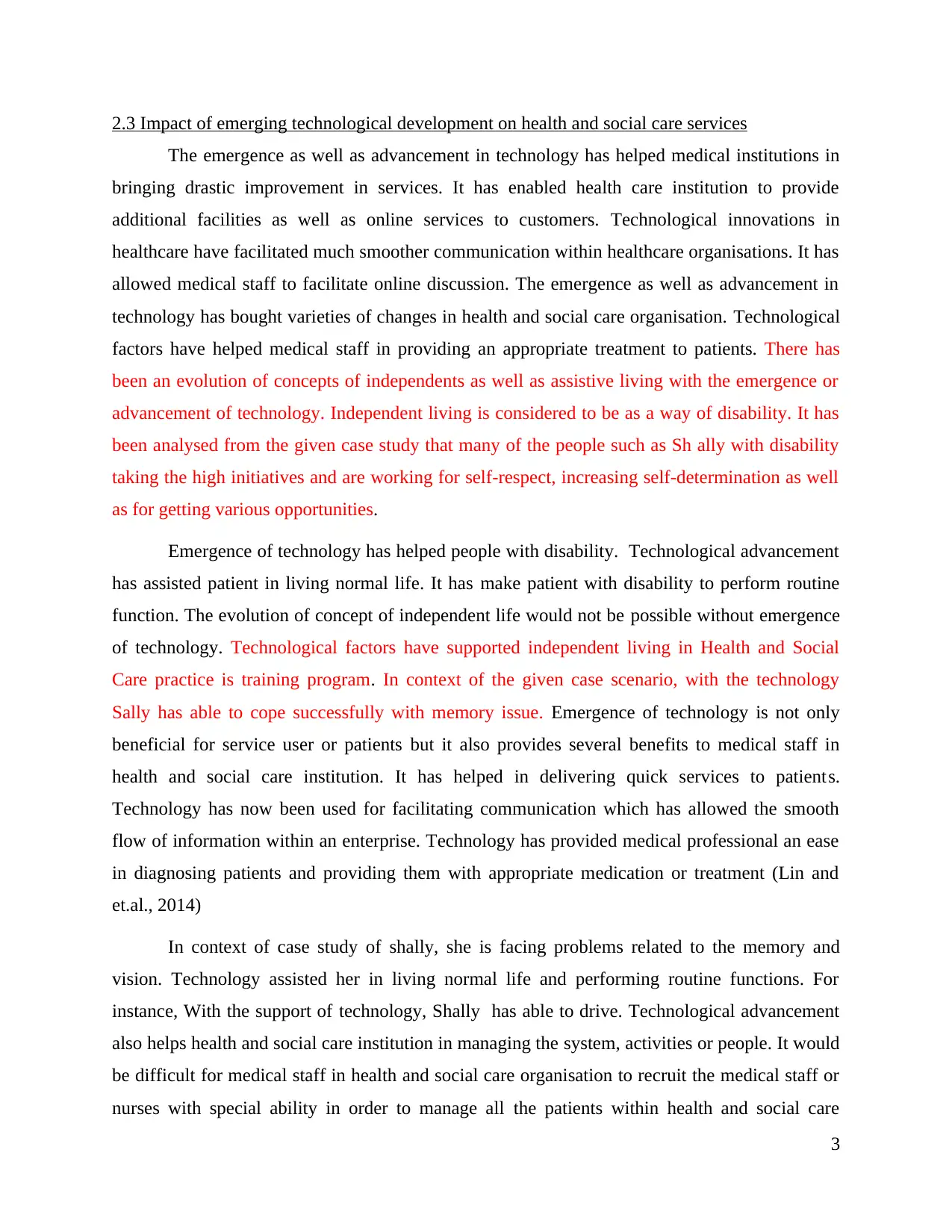
2.3 Impact of emerging technological development on health and social care services
The emergence as well as advancement in technology has helped medical institutions in
bringing drastic improvement in services. It has enabled health care institution to provide
additional facilities as well as online services to customers. Technological innovations in
healthcare have facilitated much smoother communication within healthcare organisations. It has
allowed medical staff to facilitate online discussion. The emergence as well as advancement in
technology has bought varieties of changes in health and social care organisation. Technological
factors have helped medical staff in providing an appropriate treatment to patients. There has
been an evolution of concepts of independents as well as assistive living with the emergence or
advancement of technology. Independent living is considered to be as a way of disability. It has
been analysed from the given case study that many of the people such as Sh ally with disability
taking the high initiatives and are working for self-respect, increasing self-determination as well
as for getting various opportunities.
Emergence of technology has helped people with disability. Technological advancement
has assisted patient in living normal life. It has make patient with disability to perform routine
function. The evolution of concept of independent life would not be possible without emergence
of technology. Technological factors have supported independent living in Health and Social
Care practice is training program. In context of the given case scenario, with the technology
Sally has able to cope successfully with memory issue. Emergence of technology is not only
beneficial for service user or patients but it also provides several benefits to medical staff in
health and social care institution. It has helped in delivering quick services to patients.
Technology has now been used for facilitating communication which has allowed the smooth
flow of information within an enterprise. Technology has provided medical professional an ease
in diagnosing patients and providing them with appropriate medication or treatment (Lin and
et.al., 2014)
In context of case study of shally, she is facing problems related to the memory and
vision. Technology assisted her in living normal life and performing routine functions. For
instance, With the support of technology, Shally has able to drive. Technological advancement
also helps health and social care institution in managing the system, activities or people. It would
be difficult for medical staff in health and social care organisation to recruit the medical staff or
nurses with special ability in order to manage all the patients within health and social care
3
The emergence as well as advancement in technology has helped medical institutions in
bringing drastic improvement in services. It has enabled health care institution to provide
additional facilities as well as online services to customers. Technological innovations in
healthcare have facilitated much smoother communication within healthcare organisations. It has
allowed medical staff to facilitate online discussion. The emergence as well as advancement in
technology has bought varieties of changes in health and social care organisation. Technological
factors have helped medical staff in providing an appropriate treatment to patients. There has
been an evolution of concepts of independents as well as assistive living with the emergence or
advancement of technology. Independent living is considered to be as a way of disability. It has
been analysed from the given case study that many of the people such as Sh ally with disability
taking the high initiatives and are working for self-respect, increasing self-determination as well
as for getting various opportunities.
Emergence of technology has helped people with disability. Technological advancement
has assisted patient in living normal life. It has make patient with disability to perform routine
function. The evolution of concept of independent life would not be possible without emergence
of technology. Technological factors have supported independent living in Health and Social
Care practice is training program. In context of the given case scenario, with the technology
Sally has able to cope successfully with memory issue. Emergence of technology is not only
beneficial for service user or patients but it also provides several benefits to medical staff in
health and social care institution. It has helped in delivering quick services to patients.
Technology has now been used for facilitating communication which has allowed the smooth
flow of information within an enterprise. Technology has provided medical professional an ease
in diagnosing patients and providing them with appropriate medication or treatment (Lin and
et.al., 2014)
In context of case study of shally, she is facing problems related to the memory and
vision. Technology assisted her in living normal life and performing routine functions. For
instance, With the support of technology, Shally has able to drive. Technological advancement
also helps health and social care institution in managing the system, activities or people. It would
be difficult for medical staff in health and social care organisation to recruit the medical staff or
nurses with special ability in order to manage all the patients within health and social care
3
Paraphrase This Document
Need a fresh take? Get an instant paraphrase of this document with our AI Paraphraser
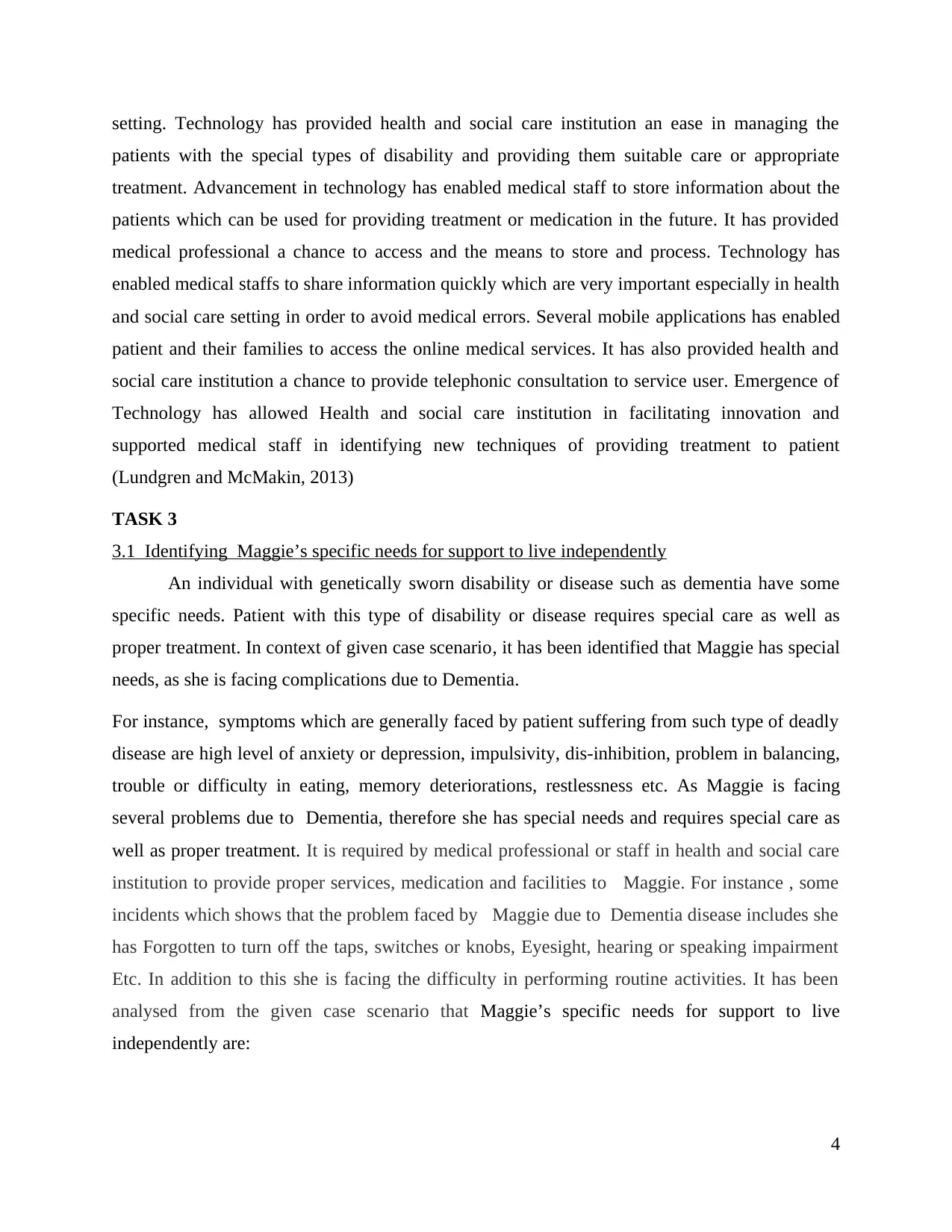
setting. Technology has provided health and social care institution an ease in managing the
patients with the special types of disability and providing them suitable care or appropriate
treatment. Advancement in technology has enabled medical staff to store information about the
patients which can be used for providing treatment or medication in the future. It has provided
medical professional a chance to access and the means to store and process. Technology has
enabled medical staffs to share information quickly which are very important especially in health
and social care setting in order to avoid medical errors. Several mobile applications has enabled
patient and their families to access the online medical services. It has also provided health and
social care institution a chance to provide telephonic consultation to service user. Emergence of
Technology has allowed Health and social care institution in facilitating innovation and
supported medical staff in identifying new techniques of providing treatment to patient
(Lundgren and McMakin, 2013)
TASK 3
3.1 Identifying Maggie’s specific needs for support to live independently
An individual with genetically sworn disability or disease such as dementia have some
specific needs. Patient with this type of disability or disease requires special care as well as
proper treatment. In context of given case scenario, it has been identified that Maggie has special
needs, as she is facing complications due to Dementia.
For instance, symptoms which are generally faced by patient suffering from such type of deadly
disease are high level of anxiety or depression, impulsivity, dis-inhibition, problem in balancing,
trouble or difficulty in eating, memory deteriorations, restlessness etc. As Maggie is facing
several problems due to Dementia, therefore she has special needs and requires special care as
well as proper treatment. It is required by medical professional or staff in health and social care
institution to provide proper services, medication and facilities to Maggie. For instance , some
incidents which shows that the problem faced by Maggie due to Dementia disease includes she
has Forgotten to turn off the taps, switches or knobs, Eyesight, hearing or speaking impairment
Etc. In addition to this she is facing the difficulty in performing routine activities. It has been
analysed from the given case scenario that Maggie’s specific needs for support to live
independently are:
4
patients with the special types of disability and providing them suitable care or appropriate
treatment. Advancement in technology has enabled medical staff to store information about the
patients which can be used for providing treatment or medication in the future. It has provided
medical professional a chance to access and the means to store and process. Technology has
enabled medical staffs to share information quickly which are very important especially in health
and social care setting in order to avoid medical errors. Several mobile applications has enabled
patient and their families to access the online medical services. It has also provided health and
social care institution a chance to provide telephonic consultation to service user. Emergence of
Technology has allowed Health and social care institution in facilitating innovation and
supported medical staff in identifying new techniques of providing treatment to patient
(Lundgren and McMakin, 2013)
TASK 3
3.1 Identifying Maggie’s specific needs for support to live independently
An individual with genetically sworn disability or disease such as dementia have some
specific needs. Patient with this type of disability or disease requires special care as well as
proper treatment. In context of given case scenario, it has been identified that Maggie has special
needs, as she is facing complications due to Dementia.
For instance, symptoms which are generally faced by patient suffering from such type of deadly
disease are high level of anxiety or depression, impulsivity, dis-inhibition, problem in balancing,
trouble or difficulty in eating, memory deteriorations, restlessness etc. As Maggie is facing
several problems due to Dementia, therefore she has special needs and requires special care as
well as proper treatment. It is required by medical professional or staff in health and social care
institution to provide proper services, medication and facilities to Maggie. For instance , some
incidents which shows that the problem faced by Maggie due to Dementia disease includes she
has Forgotten to turn off the taps, switches or knobs, Eyesight, hearing or speaking impairment
Etc. In addition to this she is facing the difficulty in performing routine activities. It has been
analysed from the given case scenario that Maggie’s specific needs for support to live
independently are:
4
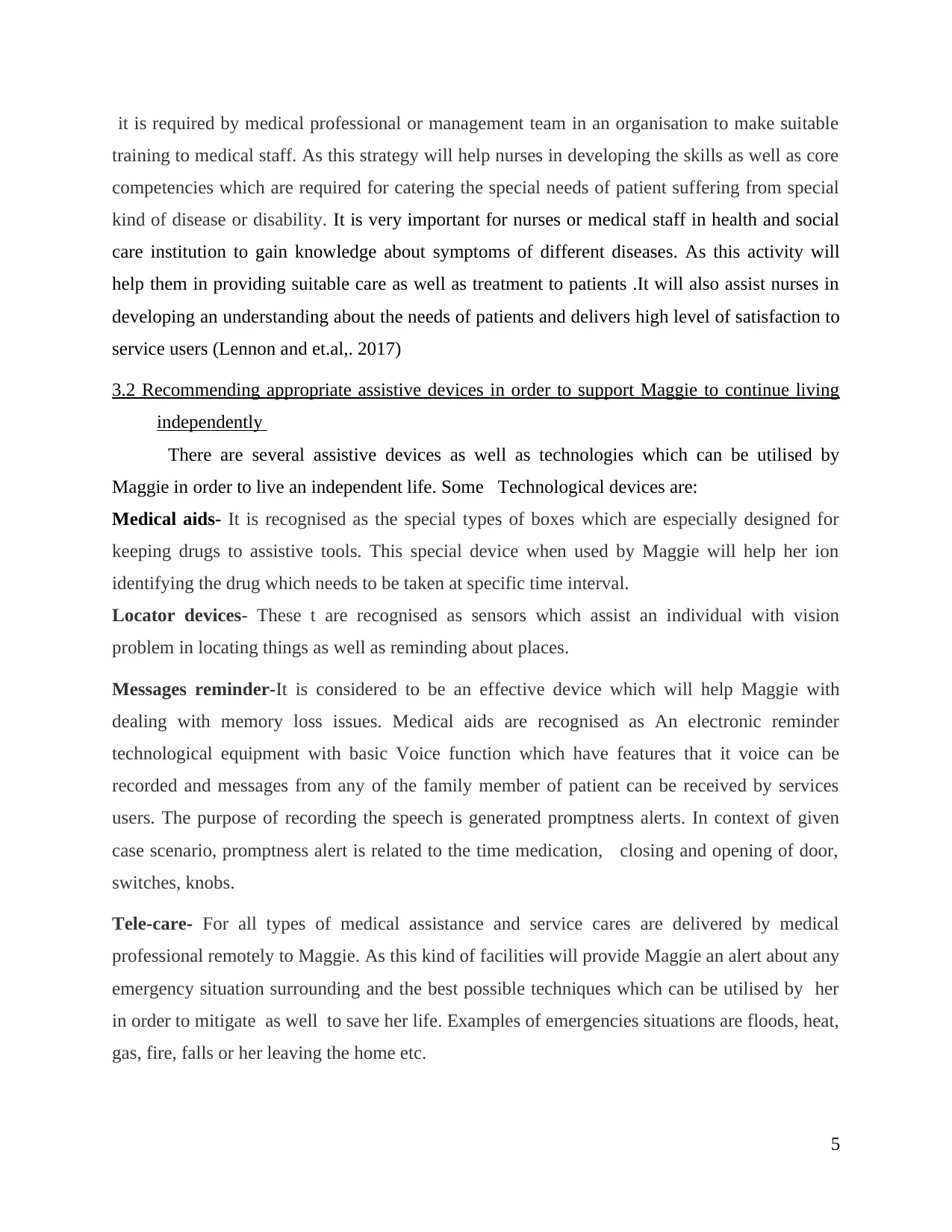
it is required by medical professional or management team in an organisation to make suitable
training to medical staff. As this strategy will help nurses in developing the skills as well as core
competencies which are required for catering the special needs of patient suffering from special
kind of disease or disability. It is very important for nurses or medical staff in health and social
care institution to gain knowledge about symptoms of different diseases. As this activity will
help them in providing suitable care as well as treatment to patients .It will also assist nurses in
developing an understanding about the needs of patients and delivers high level of satisfaction to
service users (Lennon and et.al,. 2017)
3.2 Recommending appropriate assistive devices in order to support Maggie to continue living
independently
There are several assistive devices as well as technologies which can be utilised by
Maggie in order to live an independent life. Some Technological devices are:
Medical aids- It is recognised as the special types of boxes which are especially designed for
keeping drugs to assistive tools. This special device when used by Maggie will help her ion
identifying the drug which needs to be taken at specific time interval.
Locator devices- These t are recognised as sensors which assist an individual with vision
problem in locating things as well as reminding about places.
Messages reminder-It is considered to be an effective device which will help Maggie with
dealing with memory loss issues. Medical aids are recognised as An electronic reminder
technological equipment with basic Voice function which have features that it voice can be
recorded and messages from any of the family member of patient can be received by services
users. The purpose of recording the speech is generated promptness alerts. In context of given
case scenario, promptness alert is related to the time medication, closing and opening of door,
switches, knobs.
Tele-care- For all types of medical assistance and service cares are delivered by medical
professional remotely to Maggie. As this kind of facilities will provide Maggie an alert about any
emergency situation surrounding and the best possible techniques which can be utilised by her
in order to mitigate as well to save her life. Examples of emergencies situations are floods, heat,
gas, fire, falls or her leaving the home etc.
5
training to medical staff. As this strategy will help nurses in developing the skills as well as core
competencies which are required for catering the special needs of patient suffering from special
kind of disease or disability. It is very important for nurses or medical staff in health and social
care institution to gain knowledge about symptoms of different diseases. As this activity will
help them in providing suitable care as well as treatment to patients .It will also assist nurses in
developing an understanding about the needs of patients and delivers high level of satisfaction to
service users (Lennon and et.al,. 2017)
3.2 Recommending appropriate assistive devices in order to support Maggie to continue living
independently
There are several assistive devices as well as technologies which can be utilised by
Maggie in order to live an independent life. Some Technological devices are:
Medical aids- It is recognised as the special types of boxes which are especially designed for
keeping drugs to assistive tools. This special device when used by Maggie will help her ion
identifying the drug which needs to be taken at specific time interval.
Locator devices- These t are recognised as sensors which assist an individual with vision
problem in locating things as well as reminding about places.
Messages reminder-It is considered to be an effective device which will help Maggie with
dealing with memory loss issues. Medical aids are recognised as An electronic reminder
technological equipment with basic Voice function which have features that it voice can be
recorded and messages from any of the family member of patient can be received by services
users. The purpose of recording the speech is generated promptness alerts. In context of given
case scenario, promptness alert is related to the time medication, closing and opening of door,
switches, knobs.
Tele-care- For all types of medical assistance and service cares are delivered by medical
professional remotely to Maggie. As this kind of facilities will provide Maggie an alert about any
emergency situation surrounding and the best possible techniques which can be utilised by her
in order to mitigate as well to save her life. Examples of emergencies situations are floods, heat,
gas, fire, falls or her leaving the home etc.
5
⊘ This is a preview!⊘
Do you want full access?
Subscribe today to unlock all pages.

Trusted by 1+ million students worldwide
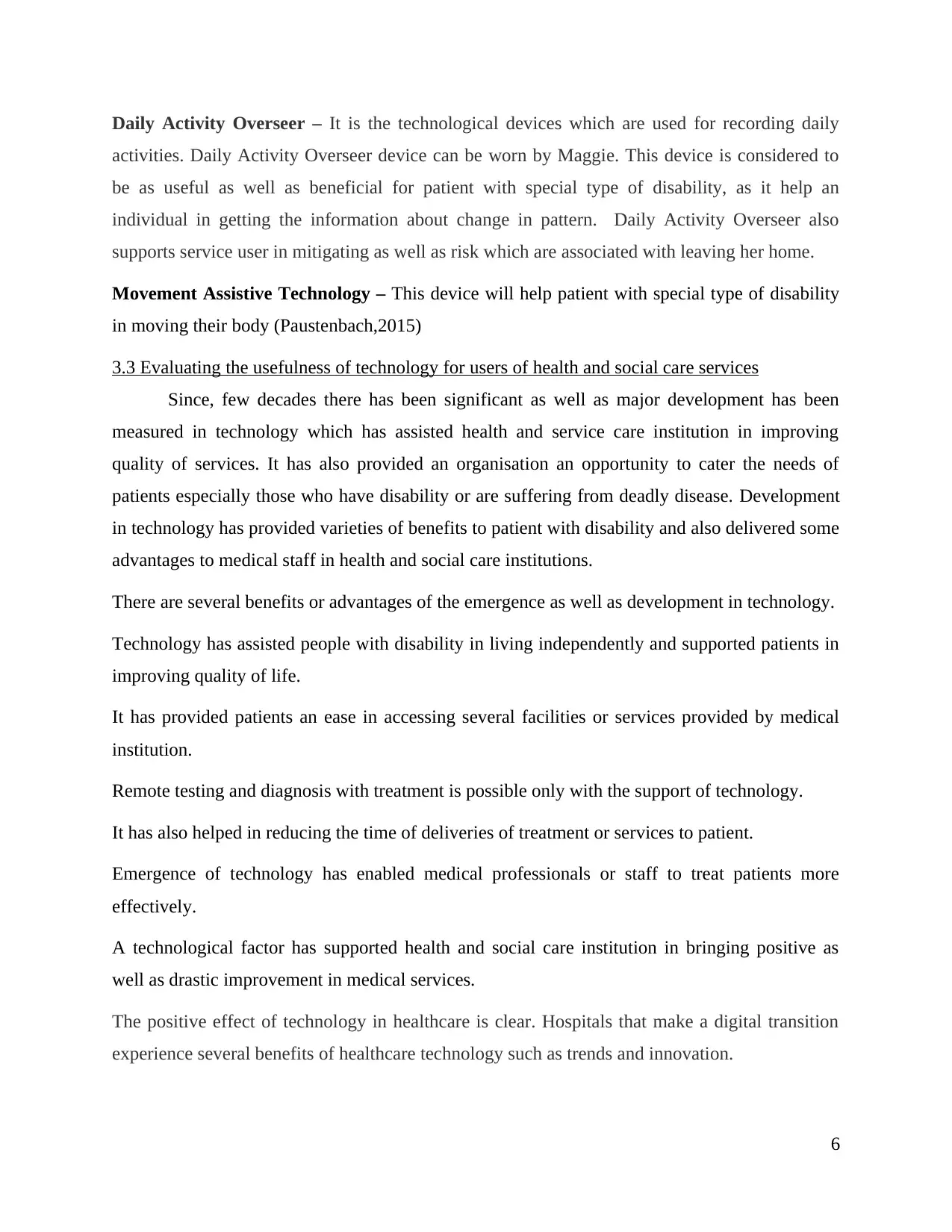
Daily Activity Overseer – It is the technological devices which are used for recording daily
activities. Daily Activity Overseer device can be worn by Maggie. This device is considered to
be as useful as well as beneficial for patient with special type of disability, as it help an
individual in getting the information about change in pattern. Daily Activity Overseer also
supports service user in mitigating as well as risk which are associated with leaving her home.
Movement Assistive Technology – This device will help patient with special type of disability
in moving their body (Paustenbach,2015)
3.3 Evaluating the usefulness of technology for users of health and social care services
Since, few decades there has been significant as well as major development has been
measured in technology which has assisted health and service care institution in improving
quality of services. It has also provided an organisation an opportunity to cater the needs of
patients especially those who have disability or are suffering from deadly disease. Development
in technology has provided varieties of benefits to patient with disability and also delivered some
advantages to medical staff in health and social care institutions.
There are several benefits or advantages of the emergence as well as development in technology.
Technology has assisted people with disability in living independently and supported patients in
improving quality of life.
It has provided patients an ease in accessing several facilities or services provided by medical
institution.
Remote testing and diagnosis with treatment is possible only with the support of technology.
It has also helped in reducing the time of deliveries of treatment or services to patient.
Emergence of technology has enabled medical professionals or staff to treat patients more
effectively.
A technological factor has supported health and social care institution in bringing positive as
well as drastic improvement in medical services.
The positive effect of technology in healthcare is clear. Hospitals that make a digital transition
experience several benefits of healthcare technology such as trends and innovation.
6
activities. Daily Activity Overseer device can be worn by Maggie. This device is considered to
be as useful as well as beneficial for patient with special type of disability, as it help an
individual in getting the information about change in pattern. Daily Activity Overseer also
supports service user in mitigating as well as risk which are associated with leaving her home.
Movement Assistive Technology – This device will help patient with special type of disability
in moving their body (Paustenbach,2015)
3.3 Evaluating the usefulness of technology for users of health and social care services
Since, few decades there has been significant as well as major development has been
measured in technology which has assisted health and service care institution in improving
quality of services. It has also provided an organisation an opportunity to cater the needs of
patients especially those who have disability or are suffering from deadly disease. Development
in technology has provided varieties of benefits to patient with disability and also delivered some
advantages to medical staff in health and social care institutions.
There are several benefits or advantages of the emergence as well as development in technology.
Technology has assisted people with disability in living independently and supported patients in
improving quality of life.
It has provided patients an ease in accessing several facilities or services provided by medical
institution.
Remote testing and diagnosis with treatment is possible only with the support of technology.
It has also helped in reducing the time of deliveries of treatment or services to patient.
Emergence of technology has enabled medical professionals or staff to treat patients more
effectively.
A technological factor has supported health and social care institution in bringing positive as
well as drastic improvement in medical services.
The positive effect of technology in healthcare is clear. Hospitals that make a digital transition
experience several benefits of healthcare technology such as trends and innovation.
6
Paraphrase This Document
Need a fresh take? Get an instant paraphrase of this document with our AI Paraphraser
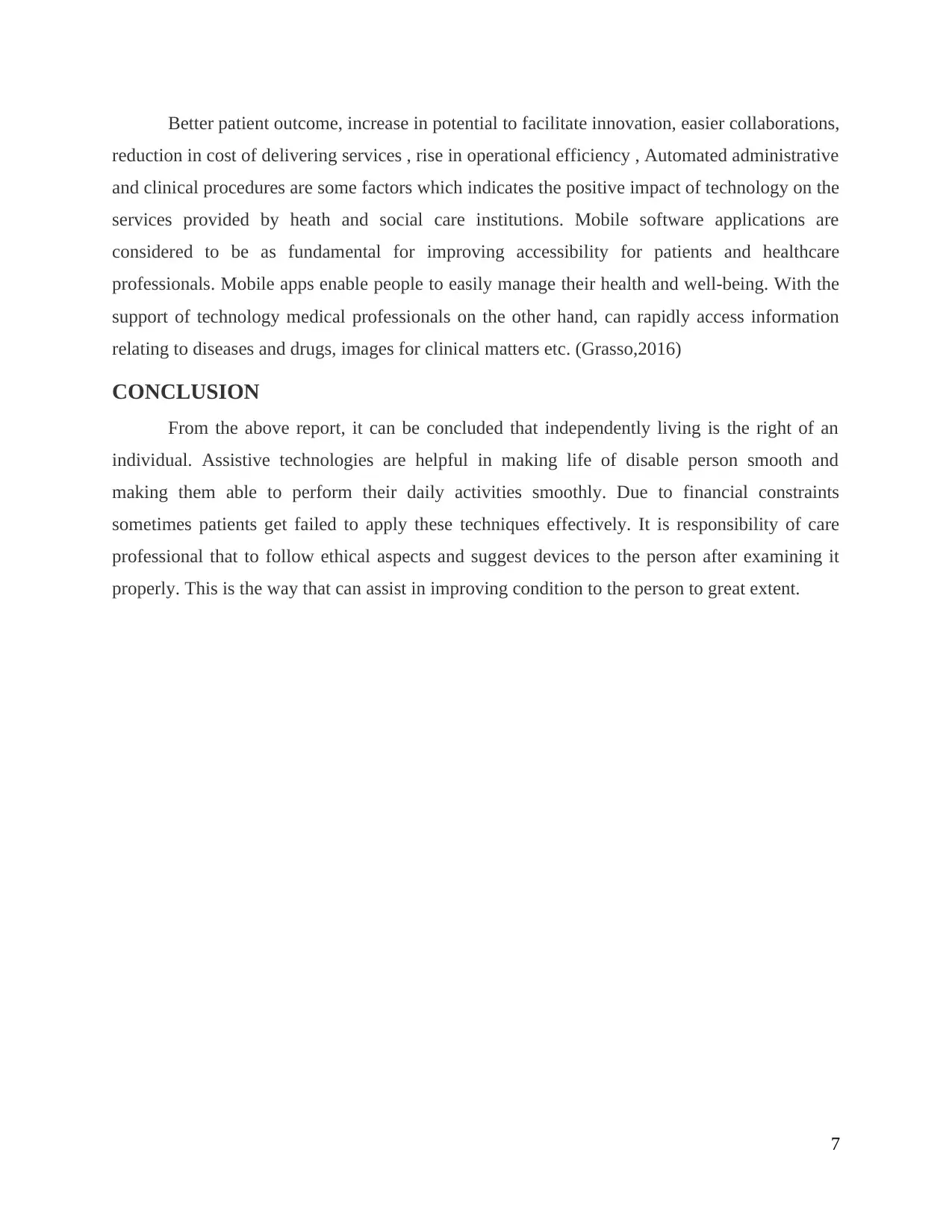
Better patient outcome, increase in potential to facilitate innovation, easier collaborations,
reduction in cost of delivering services , rise in operational efficiency , Automated administrative
and clinical procedures are some factors which indicates the positive impact of technology on the
services provided by heath and social care institutions. Mobile software applications are
considered to be as fundamental for improving accessibility for patients and healthcare
professionals. Mobile apps enable people to easily manage their health and well-being. With the
support of technology medical professionals on the other hand, can rapidly access information
relating to diseases and drugs, images for clinical matters etc. (Grasso,2016)
CONCLUSION
From the above report, it can be concluded that independently living is the right of an
individual. Assistive technologies are helpful in making life of disable person smooth and
making them able to perform their daily activities smoothly. Due to financial constraints
sometimes patients get failed to apply these techniques effectively. It is responsibility of care
professional that to follow ethical aspects and suggest devices to the person after examining it
properly. This is the way that can assist in improving condition to the person to great extent.
7
reduction in cost of delivering services , rise in operational efficiency , Automated administrative
and clinical procedures are some factors which indicates the positive impact of technology on the
services provided by heath and social care institutions. Mobile software applications are
considered to be as fundamental for improving accessibility for patients and healthcare
professionals. Mobile apps enable people to easily manage their health and well-being. With the
support of technology medical professionals on the other hand, can rapidly access information
relating to diseases and drugs, images for clinical matters etc. (Grasso,2016)
CONCLUSION
From the above report, it can be concluded that independently living is the right of an
individual. Assistive technologies are helpful in making life of disable person smooth and
making them able to perform their daily activities smoothly. Due to financial constraints
sometimes patients get failed to apply these techniques effectively. It is responsibility of care
professional that to follow ethical aspects and suggest devices to the person after examining it
properly. This is the way that can assist in improving condition to the person to great extent.
7
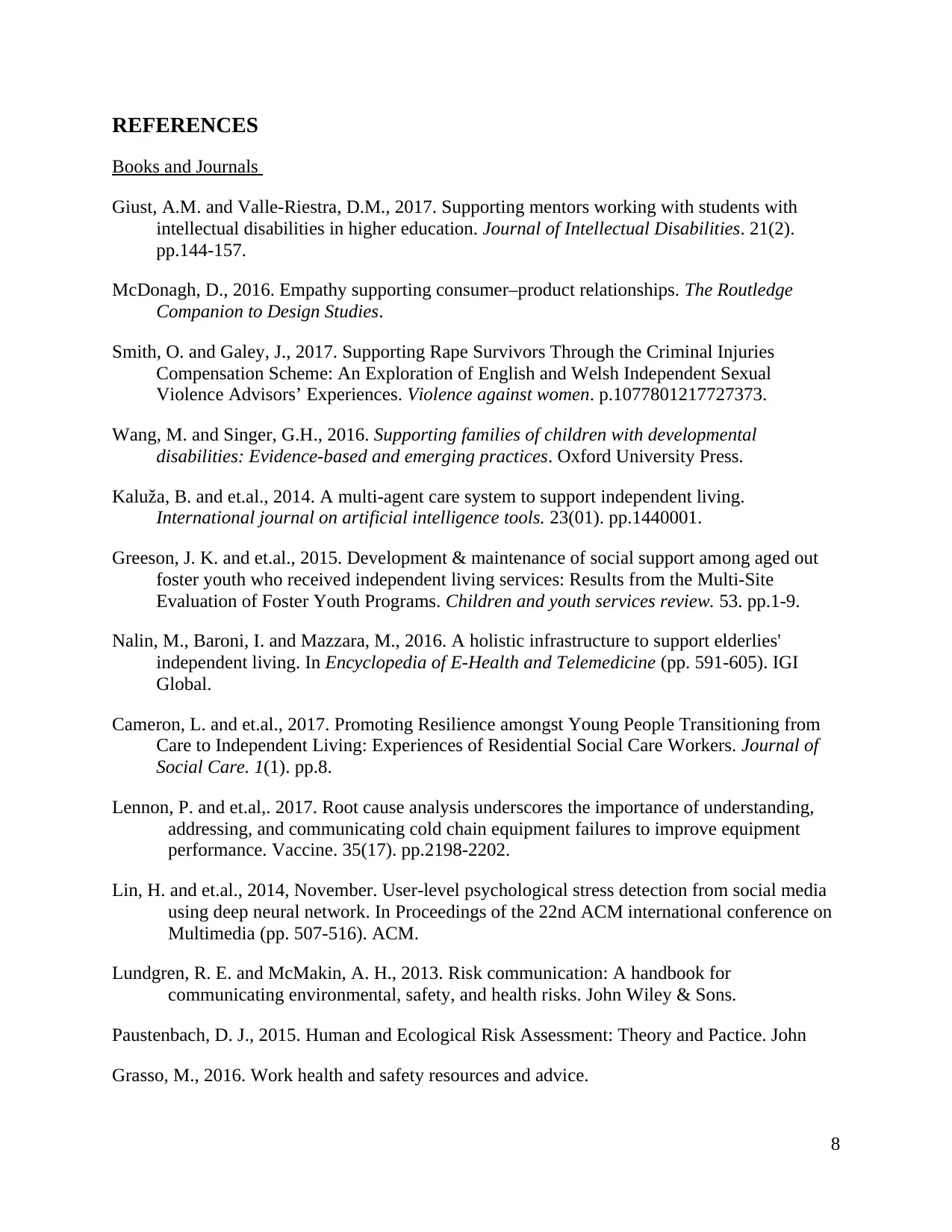
REFERENCES
Books and Journals
Giust, A.M. and Valle-Riestra, D.M., 2017. Supporting mentors working with students with
intellectual disabilities in higher education. Journal of Intellectual Disabilities. 21(2).
pp.144-157.
McDonagh, D., 2016. Empathy supporting consumer–product relationships. The Routledge
Companion to Design Studies.
Smith, O. and Galey, J., 2017. Supporting Rape Survivors Through the Criminal Injuries
Compensation Scheme: An Exploration of English and Welsh Independent Sexual
Violence Advisors’ Experiences. Violence against women. p.1077801217727373.
Wang, M. and Singer, G.H., 2016. Supporting families of children with developmental
disabilities: Evidence-based and emerging practices. Oxford University Press.
Kaluža, B. and et.al., 2014. A multi-agent care system to support independent living.
International journal on artificial intelligence tools. 23(01). pp.1440001.
Greeson, J. K. and et.al., 2015. Development & maintenance of social support among aged out
foster youth who received independent living services: Results from the Multi-Site
Evaluation of Foster Youth Programs. Children and youth services review. 53. pp.1-9.
Nalin, M., Baroni, I. and Mazzara, M., 2016. A holistic infrastructure to support elderlies'
independent living. In Encyclopedia of E-Health and Telemedicine (pp. 591-605). IGI
Global.
Cameron, L. and et.al., 2017. Promoting Resilience amongst Young People Transitioning from
Care to Independent Living: Experiences of Residential Social Care Workers. Journal of
Social Care. 1(1). pp.8.
Lennon, P. and et.al,. 2017. Root cause analysis underscores the importance of understanding,
addressing, and communicating cold chain equipment failures to improve equipment
performance. Vaccine. 35(17). pp.2198-2202.
Lin, H. and et.al., 2014, November. User-level psychological stress detection from social media
using deep neural network. In Proceedings of the 22nd ACM international conference on
Multimedia (pp. 507-516). ACM.
Lundgren, R. E. and McMakin, A. H., 2013. Risk communication: A handbook for
communicating environmental, safety, and health risks. John Wiley & Sons.
Paustenbach, D. J., 2015. Human and Ecological Risk Assessment: Theory and Pactice. John
Grasso, M., 2016. Work health and safety resources and advice.
8
Books and Journals
Giust, A.M. and Valle-Riestra, D.M., 2017. Supporting mentors working with students with
intellectual disabilities in higher education. Journal of Intellectual Disabilities. 21(2).
pp.144-157.
McDonagh, D., 2016. Empathy supporting consumer–product relationships. The Routledge
Companion to Design Studies.
Smith, O. and Galey, J., 2017. Supporting Rape Survivors Through the Criminal Injuries
Compensation Scheme: An Exploration of English and Welsh Independent Sexual
Violence Advisors’ Experiences. Violence against women. p.1077801217727373.
Wang, M. and Singer, G.H., 2016. Supporting families of children with developmental
disabilities: Evidence-based and emerging practices. Oxford University Press.
Kaluža, B. and et.al., 2014. A multi-agent care system to support independent living.
International journal on artificial intelligence tools. 23(01). pp.1440001.
Greeson, J. K. and et.al., 2015. Development & maintenance of social support among aged out
foster youth who received independent living services: Results from the Multi-Site
Evaluation of Foster Youth Programs. Children and youth services review. 53. pp.1-9.
Nalin, M., Baroni, I. and Mazzara, M., 2016. A holistic infrastructure to support elderlies'
independent living. In Encyclopedia of E-Health and Telemedicine (pp. 591-605). IGI
Global.
Cameron, L. and et.al., 2017. Promoting Resilience amongst Young People Transitioning from
Care to Independent Living: Experiences of Residential Social Care Workers. Journal of
Social Care. 1(1). pp.8.
Lennon, P. and et.al,. 2017. Root cause analysis underscores the importance of understanding,
addressing, and communicating cold chain equipment failures to improve equipment
performance. Vaccine. 35(17). pp.2198-2202.
Lin, H. and et.al., 2014, November. User-level psychological stress detection from social media
using deep neural network. In Proceedings of the 22nd ACM international conference on
Multimedia (pp. 507-516). ACM.
Lundgren, R. E. and McMakin, A. H., 2013. Risk communication: A handbook for
communicating environmental, safety, and health risks. John Wiley & Sons.
Paustenbach, D. J., 2015. Human and Ecological Risk Assessment: Theory and Pactice. John
Grasso, M., 2016. Work health and safety resources and advice.
8
⊘ This is a preview!⊘
Do you want full access?
Subscribe today to unlock all pages.

Trusted by 1+ million students worldwide
1 out of 12
Related Documents
Your All-in-One AI-Powered Toolkit for Academic Success.
+13062052269
info@desklib.com
Available 24*7 on WhatsApp / Email
![[object Object]](/_next/static/media/star-bottom.7253800d.svg)
Unlock your academic potential
Copyright © 2020–2025 A2Z Services. All Rights Reserved. Developed and managed by ZUCOL.





